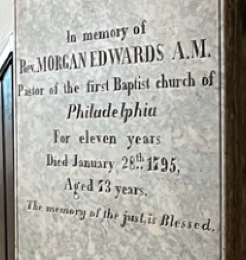Title: Baptist preacher, pastor, church historian
Birthdate: May 9, 1722
Death Date: January 28, 1795
Plot Location: Section 112, First Baptist Church plot

In 18th-century Wales the vast majority of its people spoke Welsh, but as part of the United Kingdom, some knew English as well. Born and educated at home in Wales, Morgan was raised in the Church of England, but when he turned 16 he chose a different path. He traveled east about 50 miles to attend Bristol Seminary, a Baptist college in England.
He pastored a small congregation on England’s eastern shore in the 1740s, then another church in Cork, Ireland in the 1750s. There he adapted again to the local language, was ordained as a Baptist minister, and married Mary Nunn in 1757. But Morgan was a mover, and three years later they were in East Sussex, south of London. After just a year there, he answered a trans-Atlantic call to preach in 1761 at First Baptist Church of Philadelphia, where the language was also a bit different.
Normally when churches bring in a new pastor there is a dip in attendance, but shortly after his arrival the sanctuary had to be rebuilt to house the growing membership. As before, he was not one to sit still, serving as moderator and clerk for the Philadelphia Baptist Association on numerous occasions.
In particular, he represented the association in organizing Rhode Island College in 1764. (The formal name was the “College in the English Colony of Rhode Island and Providence Plantations.”) They advocated for a school there because it was the site of the first Baptist congregation in  America.
America.
The charter required the board to be composed of Baptists as the majority, but not to the exclusion of others, setting it apart from other sectarian schools that were run solely for and by their denominations. Morgan was on the Board of Fellows for the first 25 years of the school’s existence.
In 1766 he took a year’s leave of absence from the pulpit, volunteering to raise funds for the college from his contacts in the British Isles. Among those who pledged support were Benjamin Franklin and a son of William Penn, Thomas. Meanwhile, Mary gave birth to Joshua in 1764 and William around 1767. She died in 1769, but Elizabeth Singleton married Morgan in 1771 to fill the void as mother to the boys.
Morgan was actively involved in the politics of his day. At one point was placed under house arrest for his outspoken loyalty to England during the Revolution. He was most likely the only Tory among his fellow preachers. During his tenure the church approved the right of women to vote in church affairs. After 11 years, he wanted to devote more time to writing and traveling, so he resigned as pastor of First Baptist.
Coincidentally, the man who replaced him in the pulpit was the first graduate of Rhode Island College. In fact, he was the first student of the school in 1765 and, for the first year, the only student. William Rogers was the third full-time pastor, after Jenkin Jones and Morgan Edwards. He served from 1772 until joined a Revolutionary militia as their chaplain in 1775. His own Notable life story can be found here.
The next chapter in Morgan’s story began with the family moving to a farm in Delaware. This was his busiest and most fulfilling period of his life. He was no longer limited to just one congregation, free to travel as an itinerant preacher, filling church pulpits during pastoral vacancies and for special meetings.
Coming from Wales, Morgan’s resume included preaching in different languages, but there were two others he used in preparing his sermons. They were the original languages of Scripture, Greek and Hebrew, which he mastered while in college. One biographer said his Greek New Testament and his Hebrew Old Testament were his constant companions. He called them “the minister’s two eyes.”
During the many trips he made to from New Hampshire to Georgia he promoted the new college. The congregations were encouraged to support the school by sending donations as they were able, and to recommend potential students. (Years later the school was renamed Brown University and, like the other Ivy League institutions, it strayed from its Christian roots.)
In his later years, Morgan began writing a history of the Baptist denomination in America. Not wanting to appear boastful, he modestly titled his first volume, Materials Towards a History of Baptists in Pennsylvania. From his frequent travels he compiled additional volumes about how the Gospel was spread and other Baptist churches flourished in the new nation.
At some point Morgan’s second wife died, so in 1792 he moved to the property of his third wife, Elizabeth Bankston. She was a wealthy widow who also lived in Delaware and wasn’t included in his modest will. He owned two rental properties so one was given to each son, along with his greatest treasure, his collection of books and manuscripts.
He was buried at First Baptist’s graveyard in Philadelphia and reinterred at Mount Moriah in 1860. His gravestone, shown above, hangs in the present building at First Baptist next to the pastor who preceded him, Jenkin Jones.

Support the Friends of Mount Moriah
Help us in our mission to restore and maintain the beautiful Mount Moriah Cemetery by donating to our cause or volunteering at one of our clean-up events.

